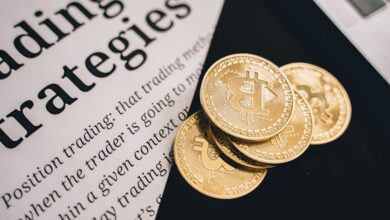Navigating Supply Chain Disruptions and Inflation: Understanding Causes, Impacts, and Strategies for Financial Security

In recent years, the world has witnessed a cascade of supply chain disruptions that have significantly impacted the economy, driving inflation to levels not seen in decades. As companies grapple with shortages and bottlenecks, the ripple effects are felt across various sectors, influencing energy prices, food prices, and ultimately the cost of living. Understanding the causes of inflation, including the interplay of monetary policy, fiscal policy, and external factors, becomes essential for navigating this complex landscape. This article delves into the multifaceted relationship between supply chain disruptions and inflation, exploring how these challenges contribute to different types of inflation—such as wage inflation and real estate inflation—and the potential for stagflation or hyperinflation. We will also examine global inflation trends and their impact on inflation metrics like the Consumer Price Index (CPI) and Producer Price Index (PPI). Moreover, we will provide actionable inflation strategies to safeguard your retirement savings against rising costs, offering insights into inflation-proof investments and effective inflation hedging techniques. Join us as we unpack the intricacies of inflation, its historical context, and the economic growth implications for individuals and central banks alike.
- 1. Understanding Supply Chain Disruptions: Key Causes of Inflation in Today's Economy
- 2. The Impact of Global Inflation Trends on Energy and Food Prices
- 3. Inflation Strategies: How to Protect Your Retirement Savings Against Rising Costs
1. Understanding Supply Chain Disruptions: Key Causes of Inflation in Today's Economy
Supply chain disruptions have emerged as a significant factor driving inflation in today’s economy. Understanding the key causes of these disruptions is essential for grasping the complex landscape of inflation.
One of the primary causes of inflation can be traced to supply chain bottlenecks, which often occur due to unforeseen events such as natural disasters, geopolitical tensions, or pandemics. These disruptions can lead to shortages of essential goods, causing prices to surge. For example, when energy prices rise due to supply chain issues, the cost of production increases across various sectors, leading to broader inflationary pressures. The ripple effect can also be seen in food prices, where logistical challenges can hinder the availability of fresh produce, further driving up costs for consumers.
In addition to external events, internal factors such as wage inflation play a critical role in the inflation equation. When businesses struggle to find workers, they may increase wages to attract talent, ultimately passing those costs onto consumers. This wage inflation compounds the effects of supply chain disruptions, creating a cycle that fuels further inflation.
Furthermore, global inflation trends can impact domestic inflation metrics, such as the Consumer Price Index (CPI) and Producer Price Index (PPI). Central banks monitor these metrics closely, often adjusting interest rates as a monetary policy response to counteract inflation. However, if inflation expectations rise, it can lead to a self-fulfilling prophecy where consumers and businesses anticipate price increases, further driving inflation.
Another noteworthy aspect is the interplay between fiscal policy and inflation. Government spending can stimulate economic growth but may inadvertently contribute to inflation if supply chains are already strained. This phenomenon is particularly evident in periods of stagflation, where economic growth stagnates while inflation continues to rise.
As individuals seek to protect their retirement savings from rising costs, inflation-proof investments, such as real estate or digital currencies, gain popularity. These assets serve as a hedge against inflation and currency devaluation, providing a safeguard for those concerned about the long-term impact of inflation on their cost of living.
In conclusion, supply chain disruptions are a multifaceted issue that significantly contributes to the causes of inflation in today’s economy. By understanding these dynamics, individuals and policymakers can better navigate the challenges posed by inflation and implement effective inflation strategies to mitigate its impact.
2. The Impact of Global Inflation Trends on Energy and Food Prices
The impact of global inflation trends on energy and food prices has become increasingly evident as supply chain disruptions continue to challenge economies worldwide. Inflation, often driven by factors such as currency devaluation and supply bottlenecks, has led to significant fluctuations in the cost of living. In recent years, energy prices have surged, contributing to wage inflation and affecting consumers' purchasing power.
As central banks adjust interest rates in response to rising inflation metrics such as the Consumer Price Index (CPI) and Producer Price Index (PPI), the interplay between monetary policy and fiscal policy becomes crucial. High energy prices, often linked to geopolitical tensions and production constraints, can exacerbate inflation expectations, resulting in a vicious cycle of cost increases across various sectors.
Food prices, similarly, are heavily influenced by both global inflation trends and supply chain disruptions. As agricultural supply chains face challenges—ranging from transportation delays to labor shortages—the cost of essential goods rises. This situation creates a scenario that some economists describe as stagflation, where stagnant economic growth coincides with high inflation, leading to a decrease in real income and a further strain on retirement savings for many households.
Moreover, inflation trends indicate a shift towards inflation-proof investments, as investors seek to hedge against declining purchasing power. Real estate inflation has emerged as a popular strategy, given its historical resilience during inflationary periods. Additionally, digital currencies are being explored as a potential hedge, although their volatility poses risks.
In summary, the interconnectedness of global inflation trends with energy and food prices highlights the complexity of inflationary pressures. Understanding the causes of inflation and the various types—including hyperinflation, disinflation, and stagflation—can aid consumers and investors in navigating this challenging economic landscape, ensuring they employ effective inflation strategies to protect their financial well-being.
3. Inflation Strategies: How to Protect Your Retirement Savings Against Rising Costs
As inflation continues to pose challenges for individuals and economies worldwide, it is crucial to adopt effective inflation strategies to protect retirement savings against the rising costs associated with various economic factors. Understanding the causes of inflation, such as supply chain disruptions, energy prices, and wage inflation, can help retirees navigate this complex landscape.
When considering inflation-proof investments, it's essential to focus on assets that tend to hold their value or appreciate during inflationary periods. Historically, real estate has been a favored option, often demonstrating resilience against inflation trends, particularly as housing prices rise. Additionally, commodities like gold and silver serve as tangible assets that can hedge against currency devaluation and inflation expectations.
Investing in inflation-indexed bonds, like Treasury Inflation-Protected Securities (TIPS), can also be an effective way to protect retirement savings. These bonds adjust their principal value according to inflation metrics, such as the Consumer Price Index (CPI) and Producer Price Index (PPI), ensuring that the purchasing power of your investment is maintained.
Another strategy to consider is diversification across various asset classes, including digital currencies, which have gained popularity as alternative investments. While they can be volatile, some investors view them as a hedge against inflation and currency devaluation, particularly in times of hyperinflation or stagflation.
Moreover, understanding the role of monetary policy and fiscal policy enacted by central banks can inform your investment decisions. Changes in interest rates can directly influence inflation and economic growth, affecting the overall financial landscape. Keeping an eye on global inflation trends and inflation metrics will help retirees anticipate shifts in the economy and adjust their strategies accordingly.
Incorporating these inflation strategies into your retirement planning can safeguard your savings against rising costs, ultimately helping you maintain your quality of life in the face of ongoing inflation challenges. By being proactive and informed, you can navigate the complexities of inflation and protect your financial future.
In conclusion, the interplay between supply chain disruptions and inflation is a critical aspect of today's economic landscape. As we have explored, the key causes of inflation stem from various factors, including energy prices and food prices, which are heavily influenced by global inflation trends and supply chain bottlenecks. Understanding these dynamics is essential for individuals seeking to navigate the complexities of inflation metrics, such as the Consumer Price Index (CPI) and Producer Price Index (PPI).
To mitigate the impact of rising costs and protect your retirement savings against inflation, it is crucial to consider inflation-proof investments and effective inflation strategies. With wage inflation on the rise and the potential for economic phenomena like stagflation and hyperinflation, being proactive in managing your finances is more important than ever.
As central banks adjust interest rates and implement monetary and fiscal policies to combat inflation expectations, staying informed about historical inflation trends can empower you to make sound financial decisions. By embracing inflation hedging techniques and exploring assets like real estate and digital currencies, you can better safeguard your wealth against the threat of currency devaluation and rising living costs.
Ultimately, understanding the multifaceted relationship between supply chain disruptions and inflation will equip you with the tools necessary to navigate this ever-evolving economic environment, ensuring that you remain resilient in the face of uncertainty and poised for sustainable growth.
References:
– [Insert relevant sources here]





